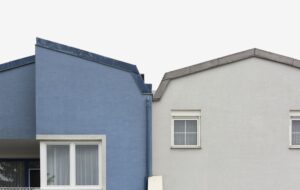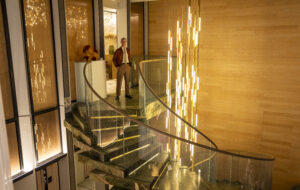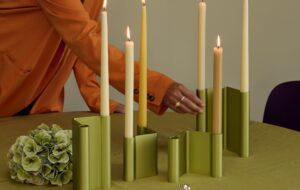|
|
||
|
Canterbury’s new Marlowe Theatre comes as something of a surprise. It’s an unexpectedly large and modern building in a historic city centre of winding, chocolate-boxy streets. Facing a new public plaza on a riverside site, Keith Williams Architects’ building presents an austere two-storey colonnade to the city; a touch of New York’s Lincoln Center in un-Manhattan surroundings of ancient priories and dinky little red-brick houses. The Marlowe has existed in Canterbury since 1949 at various locations, but at last has a home worthy of its name, the playwright author of Faustus, who was born and schooled locally. The theatre previously occupied a converted 1930s cinema, which was demolished, along with a car sales lot, to make way for the new building. As well as giving the theatre a healthy dose of civic dignity, Williams’ concrete colonnade shades the glazed lobby and ties together the aluminium-clad main auditorium and a copper-clad box containing a smaller studio theatre. Above this rises another surprise – an aluminium- and mesh-clad flytower that is shaped into a spike. “Fly towers are not normally noted for being pointy, so this is a new kind of move, perhaps,” Williams says. The fly tower addresses the cathedral, the city’s outstanding historical and architectural feature, which dominates the skyline. “It’s the biggest gig in town architecturally so we should acknowledge that,” Williams says – but the Marlowe tower, which only reaches the ridge of the cathedral’s nave, provides a new vertical landmark in a low-rise city. There’s further acknowledgement of the cathedral inside. A new, relatively tall building in the city centre, the theatre “creates” some views of the cathedral, most notably from the staircase and the first-floor bar. This view, over the rooftops of the city, was painted by artist John Doyle before the building was completed. The painting was auctioned to raise funds for the theatre, and sold for £5,000 to the actor Orlando Bloom.
The staircase itself is a handsome affair, its strong angles clad in black-painted plaster, which rises proudly through the lobby without dominating it. Williams describes it as a sculptural piece floating in the space, key to enjoyment of the evening. “The staircase should be a celebratory sort of thing,” Williams says. “[It’s] about procession, about moving; a part of going to the theatre is about showing off and seeing your friends, enjoying the whole pre-event spectacle. The staircase is part of that.” The rich walnut steps of the staircase also offer a foretaste of the main auditorium, which is clad in walnut strips – “a material I’m sort of in love with,” Williams says. But what really grabs the eye in this impressive theatre space is the seating – 1,200 seats in three tiers, supplied by Poltrona Frau and upholstered in beautiful blood-orange leather. “It’s one cow per seat, in case you’re wondering,” Williams says. “But the cows were going to die anyway.” Here Williams – whose practice also produced London’s Unicorn Theatre (2005), Wexford’s Opera House (2008) and the remodelled Birmingham Rep – has pulled off a remarkable trick. The old cinema was narrow and deep, so while the new Marlowe offers 26 percent more seats, none of them are more than 25m from the stage. “We’re wider, we’re closer, more intimate than the old space,” Williams says.
|
Image Héléne Binet
Words William Wiles |
|
|
||

















